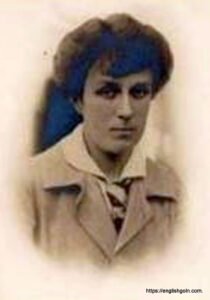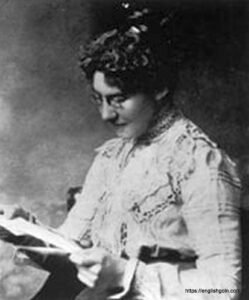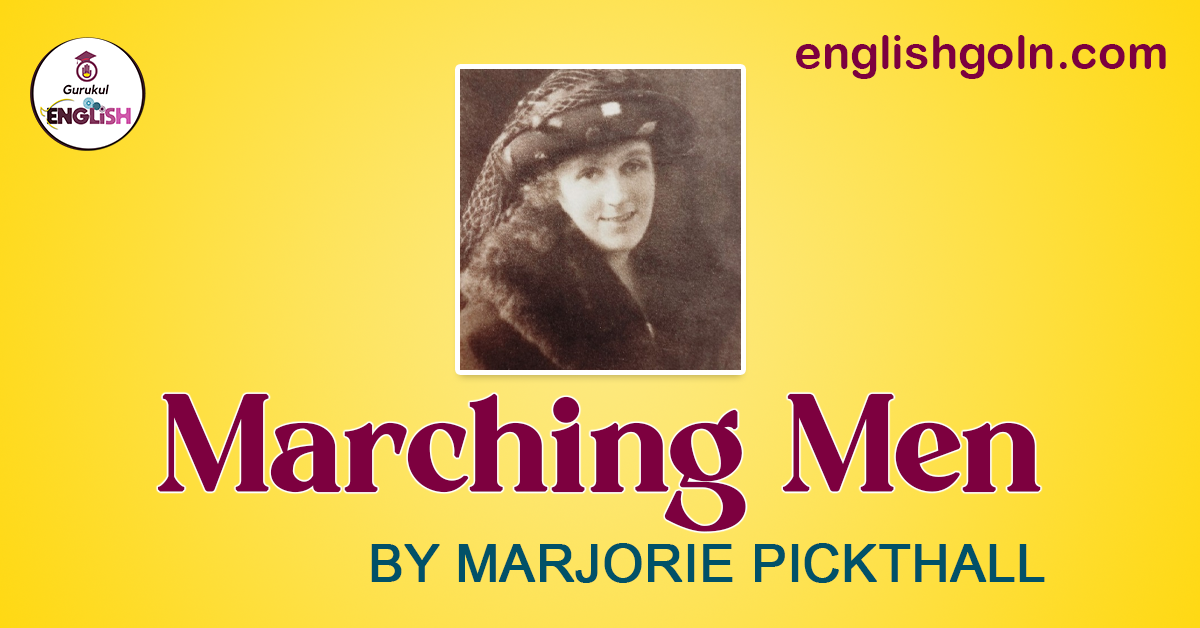“Marching Men” by Marjorie Pickthall is a powerful war poem that pays tribute to the bravery and sacrifice of soldiers. The poem offers a stark but glorified depiction of war, utilizing vivid imagery and a rhythmic, marching cadence to capture the relentless, tragic progression of men to the battlefield.

Marching Men BY MARJORIE PICKTHALL

Analysis:
- Form and Structure: “Marching Men” follows a consistent rhythm and rhyme scheme that mimics the steady, ceaseless movement of marching soldiers. This pattern creates a sense of inevitability and continuity, mirroring the poem’s theme of the unending cycle of war. The poem’s structure, composed of four quatrains, also helps establish a solid and uncompromising feel to the narrative.
- Rhythm and Rhyme: The rhythm of the poem is particularly effective in conveying its message. The steady beat of the lines captures the relentless pace of marching soldiers, creating a sense of momentum and inevitability. The use of a regular ABAB rhyme scheme also contributes to this rhythmic quality.
- Imagery and Language: Pickthall employs vivid and impactful imagery in her poem. Phrases like “Under the level winter sky” and “Trampling the terrible winepress” paint a stark picture of the battlefield, while “Marching as to a bridal song” provides a haunting contrast between the grim reality of war and the joy of a wedding. The language used is highly descriptive, allowing the reader to visualize the scene clearly.
- Theme and Tone: The poem’s central theme is the sacrifice and valor of soldiers. Despite the harsh reality of war, the men are portrayed as heroic figures, marching unwaveringly into the face of danger. The tone is solemn and respectful, reflecting the poem’s serious subject matter.
- Symbolism: Pickthall uses a range of symbols to convey her message. For example, the “level winter sky” could symbolize the cold, unfeeling nature of war, while the “bridal song” may represent the bond between soldiers and their homeland, suggesting that they are wedded to their duty.
- Aesthetic Quality: Despite its grim subject matter, “Marching Men” possesses a strong aesthetic quality. Pickthall’s skillful use of language, rhythm, and imagery lends a sense of beauty to the poem, creating a powerful contrast with its depiction of the harsh realities of war. This aesthetic quality serves to heighten the impact of the poem’s message, illustrating the poignant tragedy of war in a way that is both emotionally resonant and visually striking.
- Use of Contrast: The poem employs powerful contrasts to underline the grim reality of war and its impact on the soldiers. The notion of “Marching as to a bridal song,” a line that suggests joy, celebration, and the start of something new and beautiful, stands in sharp contrast to the image of men marching into the bloody reality of war. This serves to underline the brutal loss of life and the devastation caused by warfare.
- Mood and Atmosphere: The language and imagery of the poem create a mood of solemn reverence and deep sadness. The atmosphere is heavy with the knowledge of the inevitable – that the soldiers are marching towards death. Yet, there’s an element of valor and honor in their relentless, unified progression.
- Use of Alliteration: The poem utilizes alliteration to enhance its rhythm and emphasize its imagery. For instance, the phrase “Tread them to a dove’s soft moan” repeats the ‘m’ sound, creating a musical quality that reinforces the cadence of marching men, while also emphasizing the juxtaposition of harsh trampling and the soft moan of a dove.
- Personification: Pickthall uses personification to convey the power and relentlessness of war. The “red road” is an inanimate object but is given the human quality of thirst, suggesting that the path of war is unquenchably thirsty for the blood of soldiers.
- Connotations: The poem’s language carries various connotations that add to its overall meaning. For example, “winepress” historically refers to a device used to extract juice from crushed grapes for wine, but in this context, it symbolizes the violent squeezing of life (symbolized by the blood or ‘wine’) out of the soldiers.
- Exploration of the Human Condition: Beyond the depiction of war, the poem also explores the broader human condition. The relentless march could represent the unstoppable passage of time and the inescapable nature of death. The valor of the soldiers may reflect on how humans find meaning and nobility even in the face of life’s harshest realities.
- “Marching Men,” with its rich, evocative language, rhythmic structure, and poignant imagery, presents a haunting exploration of war and sacrifice. It stands as a tribute to the courage of soldiers while starkly underscoring the tragic, relentless cycle of war.

“Marching Men” is a powerful exploration of the themes of war, bravery, and sacrifice. Its steady rhythm, vivid imagery, and careful use of symbolism combine to create a poignant portrayal of the harsh realities of war, while its strong aesthetic quality serves to heighten the impact of its message. Through its lyrical quality, emotional depth, and blend of Romantic and Gothic elements, “Annabel Lee” remains one of Poe’s most celebrated works.
